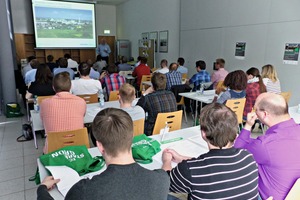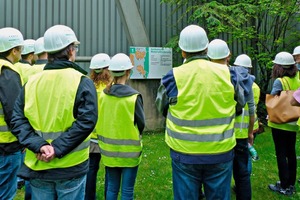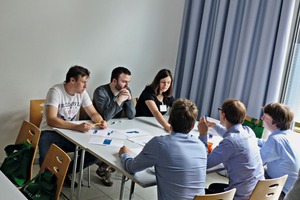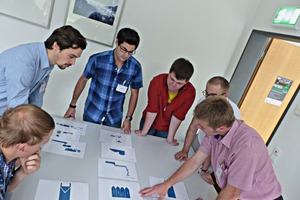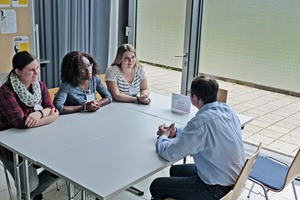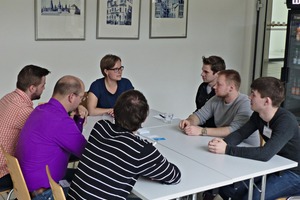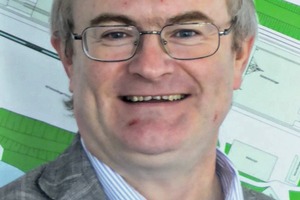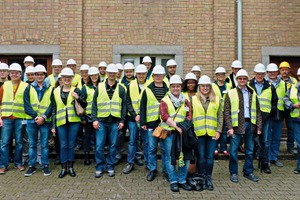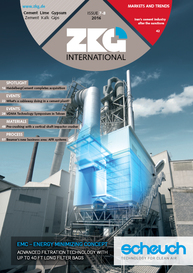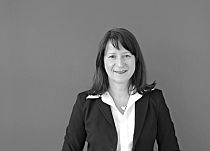What’s a cableway doing in a cement plant?
This was the interesting conundrum faced by students from the mechanical engineering and economics departments of Koblenz University of Applied Sciences and the process-engineering and mineral resources departments of Bochum University of Applied Sciences/THGA. More than 25 students and their lecturers were pleased to accept an invitation by ZKG International and a number of participating industrial partners to this study tour to Heidelberg on 14.06.-15.06.2016. The plant visit this year was to the HeidelbergCement AG home plant at Leimen, around 10 km from Heidelberg.
1 From theory to practice
Anett Fischer, Editor-in-Chief of ZKG International, opened the event by briefly introducing the speakers from the four industrial partners, Aumund Fördertechnik GmbH, FLSmidth Pfister GmbH, Gebr. Pfeiffer SE and thyssenkrupp Industrial Solutions AG.
The focus on the first day was the visit to the cement plant. Dr. Ulrich Schneider, HeidelbergCement AG’s plant manager at Leimen, discussed in his paper, entitled “Cement production - from feed materials to end product”, the company’s original Leimen plant, founded in 1896. Limestone and marl for the plant comes from its own quarry. The feed materials, comminuted to ballast size, are conveyed into the cement plant by means of a
cableway, a cost-intensive solution. The plant, however, is located right in the town, and this avoids large-scale road haulage, with all its detrimental effects. The limestone thus delivered is stacked layer-by-layer in a blending bed which assures sufficient supplies for a week of clinker production. Iron oxide and sand are added to the crushed material before it is dried and ground to meal fineness in the rawmills. Calcining takes place in two Lepol kilns with capacities of 1000 t/d and 1500 t/d, respectively. The use of secondary raw materials and refuse-derived fuels is now one of the most important topics in cement production, as Dr. Schneider noted. In 2015, for example, around 30 % of primary fuel needs were replaced by meat and bone meal, plastics and used oil, thus saving some 10 % on fuel costs. The cement clinker is stored in silos and then ground, with the metering in of additives. Although more than 1 million t of cement were made here in the record year of 1964, the current around 120 employees and ten trainees produced some 619 000 t of cement, in ten different grades, in 2015. A range of binders are used at this plant. Schneider, in closing, stated his conviction: “Cement is sexy – but we often simply don’t know it!”
This technical address was followed by Natalie Greineck, Head of Recruitment Management at HeidelbergCement AG, presenting the Group to the students. The group has had activities, up to now, at 2300 locations in forty-two countries, and employed 45 000 people. Following the takeover of Italcementi, these figures rise to around 60 000 people in sixty countries working for HeidelbergCement AG, for which 2015 was the best year since the financial crisis. Natalie Greineck illustrated potentials for development to the students, starting from internships, via degree theses, up to and including training programmes and career opportunities at HeidelbergCement.
The joint midday break was used for initial talks between the students and the industrial partners. All then moved off to Leimen, where two groups received a guided tour of the plant. This excursion aroused great interest among the students. The secret of the cableway was now finally disclosed, with this system conveying limestone into the plant above the students’ heads. The young people were extremely impressed by the production technology and process operations at Leimen, the group’s oldest plant. Much of the equipment has already had a long productive life, but nonetheless continues to function under tough everyday industrial conditions.
2 Group work and speed dating
The return to Heidelberg showed that everyone had kept their eyes open and studied the plant with great interest. The students, now split into four groups, were set the task of putting diagrams of the production sequence in the cement plant in the right order – an exercise which all accomplished relatively quickly.
In addition to a “jobs board”, on which the attending companies could display their job openings, and also Bachelor and Master’s degree opportunities, a speed dating session was also on the afternoon agenda. One important aim of this event is that of networking the companies and students intensively with each other. Again divided into four groups, the representatives of the individual companies had the opportunity of showcasing their products and activities, while the students asked questions. This activity was extremely well received by all, and the contacts made were further intensified during the joint evening meal at the Kulturbrauerei brewery restaurant in Heidelberg.
3 Plant engineering for the cement industry
The second day was entirely taken up by the papers presented by the four industrial partners, who highlighted their companies, their activities and the available career opportunities.
3.1 The FLSmidth Pfister presentation
Markus Pfeil, of FLSmidth Pfister GmbH, kicked off with his paper, entitled “Meet FLSmidth Pfister”. His aim was to show the students that the course of a career can vary greatly. The Area Sales Manager cited his own CV to illustrate that periods working abroad are a very valuable experience.
Pfeil gave his listeners three tips: 1. Gather international experience, 2. Not every career can always continue moving upward, 3. Always be loyal to your company, then you’ll always be able to come back.
Following this review of his own personal experience, Pfeil then focussed on FLSmidth Pfister. The cement, power generating, steel and minerals industries are the principal markets for this mechanical engineering firm founded in 1894. Some 2700 examples of its well-known metering rotor-weighfeeder are now in successful use. One application, for example, is metering of alternative fuels in cement plants. Pfister supplies solutions – around the globe - that cover storage, metering and pneumatic conveyance. In addition to its home facilities in Augsburg, the company also has production sites in China and India. The latter location now produces 400 to 500 metering belt weighers annually. A job at FLSmidth Pfister, with its total of 500 employees, 120 of them at Augsburg, means working in low-rise hierarchies. The parent group, FLSmidth, also offers a large and diverse range of career opportunities.
3.2 Working in international plant engineering – an insight
Kerstin Finlay and Dr.-Ing. Rodrigo Gomez, both of thyssenkrupp Industrial Solutions AG, jointly presented information to the students. Finlay, Head of Human Resources, firstly focussed on the group, with its more than 150 000 employees, and on the Industrial Solutions division, employing 19 000 people. The prime emphases at Industrial Solutions, a classical mechanical and general engineering enterprise, are on mining, cement and services. The proportion of engineers working for the company is high, at 45 %, and they evolve solutions for industry, ranging from individual machines up to and including complete production lines. One current major project is the construction of two 10 000 t cement lines in Saudi Arabia.
Gomez, a process engineer, told the students about his functions within the company. One of his responsibilities is the reduction of CO2 emissions in the cement industry. Gomez showcased an App which is to be completed in 2016. The development aim: comparison of the CO2 emissions from a range of different cement plant configurations. Gomez advised the young people attending to get as much experience of practical work as possible, because it teaches so much. Teamwork, expertise and responsibility are all important ingredients.
Kerstin Finlay then examined in detail the various potentials for development within the company, ranging from Bachelor theses, via internships, etc. etc.
3.3 The project engineer at GPSE –
opportunities for entry and development
The speakers from Gebr. Pfeiffer SE, Christoph Geupel, Chief Officer, Finance and Human
Resources, and Carsten Vieth, Head of Human Resources, also appeared as a “duo”.
Geupel spotlighted the family-managed company founded in 1864, which employs just on 500 people and achieved sales of more than 140 million € in 2015. Gebr. Pfeiffer SE is internationally known for its vertical roller mills. The first such machine was constructed for the cement industry as long ago as 1894, and 2500 are now in use in the cement and power generating industries around the world. According to Geupel’s data, the MVR 6700 C-6 mill sold in 2011 is the highest power mill anywhere around the globe. Gebr. Pfeiffer SE has international positioning, with subsidiaries in the USA, Brazil and India. Pfeiffer continues to produce high-precision machines in Germany, and operates, for example, its own foundry here.
Carsten Vieth emphasised that company-sponsored further training is a priority at Pfeiffer SE. Student interns are systematically encouraged, and Gebr. Pfeiffer SE awards grants. Like the other three industrial partners, Pfeiffer is also seeking marketing, project and commissioning engineers. Low hierarchies, future-safe jobs, active health management, flexible working times and working-hours models make joining Gebr. Pfeiffer SE an attractive proposition.
3.4 Content. Tasks. Responsibilities. –
Practice-orientated project review at Aumund
Anne Passen showcased Aumund Fördertechnik GmbH, founded in 1922 and now in the third generation of family management. Passen, Head of the Conveying Systems Design group, examined the company’s product portfolio, which extends to clinker storage facilities, chain and belt-type bucket elevators and deep-drawn pan conveyors for the cement industry, inter alia, and these products’ applications. She cited an example in Balboa, Spain, to outline a typical practice-orientated project sequence at Aumund - from planning, via installation and its supervision (by Aumund), up to and including the completed facility. Passen used a flow-sheet to illustrate the path from the cus-tomer’s enquiry, via drafting of the bid, award of the contract, design, installation and commissioning. The subject of spare and wear parts also plays an important role at Aumund. Passen, who has worked for the Franz-Walter Aumund Foundation since 2013, provided the students with an overview of the company’s development and informed them about opportunities for joining the Aumund Group. These included degree, Bachelor’s and Master’s theses.
4 Arousing newcomers’ enthusiasm
for the cement industry and its suppliers
ZKG International has organised the ZKG technical excursion under this motto for many years. Together with loyal industrial partners, we arouse students’ enthusiasm for an industry which is generally not yet high on their list of desirable employers.
We wish here to thank Aumund Fördertechnik GmbH, FLSmidth Pfister GmbH, Gebr. Pfeiffer SE and thyssenkrupp Industrial Solutions AG, whose contributions have made this event possible. Our thanks also go to HeidelbergCement AG, and to its Leimen cement plant, in particular, for their support and for the opportunity of seeing a cement plant in operation close up.
Working together, we enable future managerial staff to gain at first hand a picture of the cement industry and its subsuppliers and to make initial contacts.
This successful series of events will be continued in 2017.

